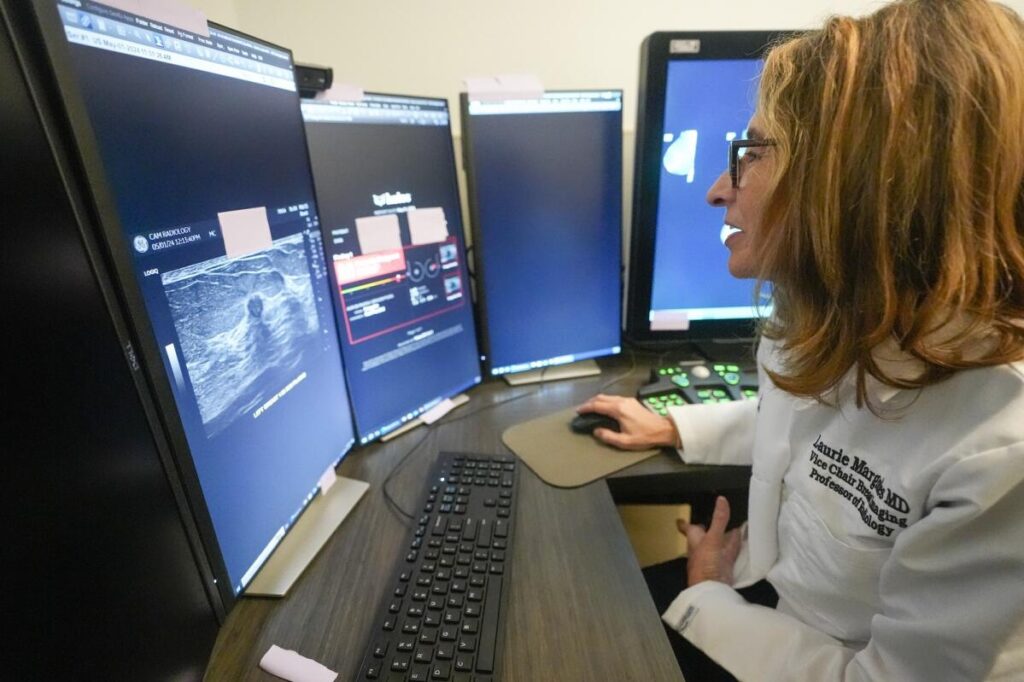Dr. Laurie Margulis demonstrates Koios DS Smart Ultrasound software, Wednesday, May 8, 2024, at Mount Sinai Hospital in New York. Breast imaging AI is used to get second opinions on mammography ultrasounds. “I'll tell patients, 'I saw it, and the computer saw it, and we both agree,'” Margulies said. “To hear me say that we both agree, I think that gives the patient even more confidence.” (AP Photo/Mariam Al Tafar)
The COVID-19 pandemic highlighted the critical need for medical innovation to improve public health outcomes. Thankfully, rapid advances in artificial intelligence (AI) can predict the next infectious disease — or even your next bout with the flu — before it becomes a problem.
As pharmacists, we are always mindful of what tools and resources are on the horizon that can fuel cutting-edge research and development into the next generation of life-changing pharmaceuticals and therapies. AI-powered medical technology, with its potential, is rapidly gaining interest across our industry.
Imagine being able to detect the flu or other virus days before symptoms appear and without an invasive procedure like a cotton swab test or even a doctor's visit. Predictive health monitoring can be a game changer in saving lives.
Enter the Rapid Analysis of Risk Exposure (RATE) algorithm. Developed in partnership between Philips and the Department of Defense, RATE is poised to revolutionize the public health landscape by leveraging advanced data analytics and artificial intelligence. The algorithm uses massive machine learning to act as an early warning system for the body. By analyzing biometric data, it can identify many health problems before diagnostic testing.
During years of field testing, the researchers extracted data from more than 7 million hospital patient encounters, studying 165 different biomarkers. They realized that the algorithm could easily be programmed into a wearable such as a smartwatch or ring. One of their studies showed that a wearable device with RATE could assess vital signs to detect COVID-19 up to six days before testing.
This cutting-edge technology boasts endless uses for countless industries. Consider RATE's ability to help our brave service members. Algorithms can rapidly assess the health and readiness of soldiers before deployment while preventing the spread of disease in close quarters where military personnel work. Identifying which individuals may need to be quarantined during a viral infection will enhance military preparedness. RATE can give the US military a competitive advantage in terms of health and safety protocols.
Beyond the battlefield, RATE can advance public health in our everyday lives — whether it's keeping emergency rooms at capacity during a pandemic or digital health for the uninsured without costly doctor visits. Help with access.
By combining the expertise of trial technology with the resources and strategic vision of a government agency such as the DoD, the RATE algorithm represents a model for effective coordination. Congressional action last year invested an additional $10 million to fund the next phase of RATE's development. It aims to make the technology more scalable and functional in the coming years.
Lawmakers on Capitol Hill deserve praise for funding programs like RATE, but more investment in public-private partnerships needs more support. Additional funding for these types of programs will enable widespread implementation, training and continued refinement of AI-powered medical technology. Perhaps no elected official understands the potential benefits these programs can provide for our military like Sens. Gary Peters (D-MI) and Joni Ernst (R-IA). Both senators serve on the Senate Armed Services Committee and both senators are also members of the Senate Artificial Intelligence Caucus, which was created in 2019.
Sen. With leaders like Ernst and Sen. Peters, we must be confident that these investments will remain a priority in Congress.
In an era marked by global health challenges, the demand for innovative solutions has never been greater. While we cannot accurately predict the next pandemic, we can be prepared with the best tools to protect our public health and national security. Future generations are counting on our legislators to fuel medical advances in the private sector.
Brett Barker is a Doctor of Pharmacy in Nevada, Iowa.
Opinion content represents the views of the author or the Gazette's editorial board. You can join the conversation by sending a letter to the editor or a guest column, or by suggesting a topic for an editorial at editorial@thegazette.com.
